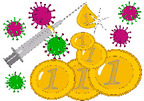Economic evaluation of HPV vaccination in Austria

Project leaders: Ingrid Zechmeister-Koss
Project team: Ingrid Zechmeister-Koss
Duration: August 2007 - December 2007
Research question/objective: Various epidemiological observations have shown a correlation between infections with certain human papilloma viruses and the development of cervical carcinoma, respectable carcinoma in its early stages. Recently, though only secondary to the successful screening programmes for early detection (pap smear tests), immunization against some high-risk HPV types became possible. Now, after the approval of the vaccines, health care decision-makers are required to decide, if and, if so for which sub-groups the vaccination should be financed by public resources. Central criteria for deciding are the potential for actually preventing disease and death, resp. the anticipated health effect and accordingly, the expected costs and cost-reductions. As a basis for sound information regarding this, health economic models have been developed in other countries. This assessment conducts a cost-effectiveness analysis for HPV immunization for the Austrian context and is supposed to make a prognosis of the expected impact of a vaccination on defined health-parameter life-years saved, avoided events and costs in comparison to screening alone.
Method: Adaptation of the Norwegian health economic HPV model and calculation of different vaccination strategies
Publication: HTA-Projektbericht 09
Contact: Ingrid Zechmeister

















